Gold Medal Garden
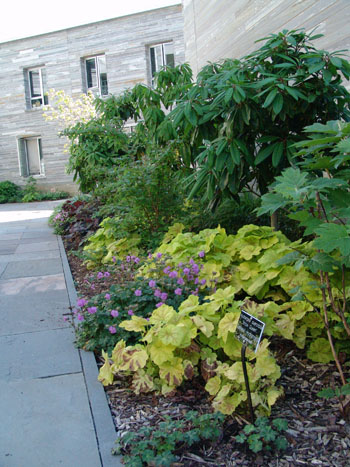
The Gold Medal Award Program of the Pennsylvania Horticultural Society was originally conceived by J. Franklin Styer in 1979. This award recognizes outstanding woody, ornamental trees, shrubs, and vines. Each year the Gold Medal Plant Award Committee, made up of horticulturists, nurserymen, and plant experts throughout the Delaware Valley, selects several plants to receive the Gold Medal designation.
For the last 30 years the Scott Arboretum has been showcasing most of the Gold Medal selections throughout its collections. In recent years, the Arboretum has been creating a Gold Medal garden around the newest student dormitories, Alice Paul and David Kemp Residence Halls. These two buildings sit between Mertz Residence Hall and Chester Road. The gardens surrounding these buildings are planted with both specimens and masses of Gold Medal selections from the last several decades.
The plants that are designated as a Gold Medal selections are denoted with a Gold Medal medallion on a stake next to the plant. More information on the Gold Medal program can be found at www.goldmedalplants.com.
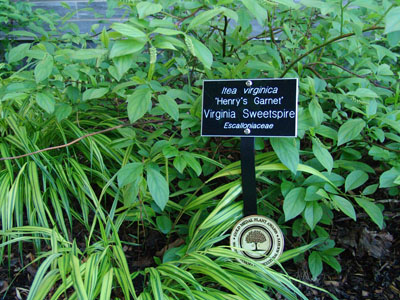
A planting of Itea virginica 'Henry's Garnet' in the Gold Medal garden. photo credit. R. Robert
The following are some great representative plants of the Gold Medal program. One of the earliest winners of this award was Itea virginica ‘Henry’s Garnet’, Virginia sweetspire. This plant originally came from the Henry Foundation in Gladwyne, but was named at the Scott Arboretum in the mid-1970s. From June to July, it is covered in bottlebrush-like white flowers which have a sweet fragrance. In fall, the narrow foliage turns a beautiful merlot-purple. At maturity, I. ‘Henry’s Garnet’ will reach up to five feet tall and will eventually spread into a thick colony. This native plant is tolerant of fairly moist conditions.
Another excellent native shrub is the sweet pepperbush, Clethra alnifolia ‘Ruby Spice’. Like the Itea, this is a colonizing shrub. In August, the bottlebrush-like flowers turn deep pink with a striking fragrance. In the fall, the foliage turns a beautiful golden yellow.
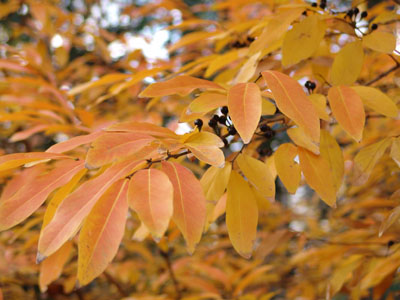
Lindera glauca var. salicifolia fall color. photo credit: J. Jin
Recently added to the plantings at Kemp Hall is another excellent shrub for fall color, the pale spicebush, Lindera glauca var. salicifolia. Like other spicebushes, this lindera is resistant to deer grazing. In the fall, the narrow foliage turns from yellow to pumpkin-orange and eventually to beige-brown. While it is ultimately a deciduous plant, the foliage stays all winter giving this large shrub great winter interest. As the old leaves shed in the spring, it bears clusters of tiny yellow flowers.
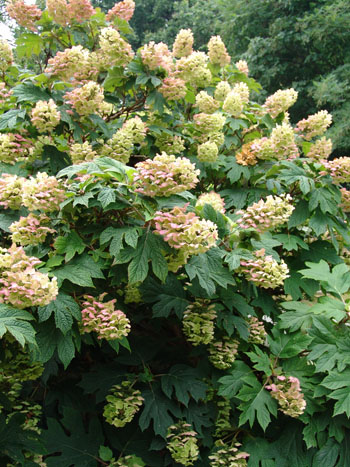
Blooms of Hydrangea quercifolia 'Snow Queen'. photo credit: R. Maurer
One of the best oakleaf hydrangeas is represented in this garden: Hydrangea quercifolia ‘Snow Queen’. This selection hales from Princeton Nursery in New Jersey. It was selected for the abundance of cone-like panicles of white flowers which emerge in July. In the fall, the leaves which resemble red oak leaves turn purple-red. This relatively large shrub can reach twelve feet tall and wide at maturity.
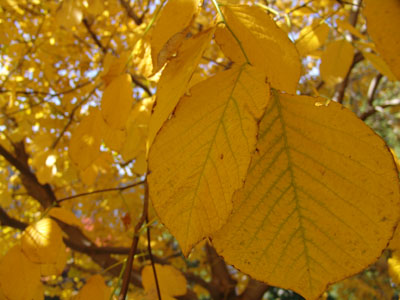
Fall color of Cladrastis kentukea. photo credit: R. Maurer
Several trees grow around Alice Paul and David Kemp Residence Hall. The American yellowwood, Cladrastis kentukea forms a beautiful vase-shape over time. The compound foliage turns a striking golden-yellow in the fall. With maturity, the bark will become smooth and silver like that of our native beech, Fagus grandifolia. In May, this medium-sized tree is covered with pendant clusters of sweetly scented white flowers with a slight pink blush.
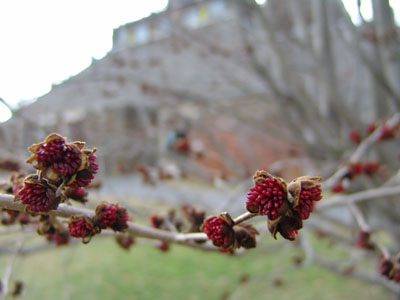
The late winter flowers of Parrotia persica. photo credit: R. Maurer
For fall and winter interest an excellent choice is the Persian ironwood, Parrotia persica. This is often grown as a multi-stemmed tree. The largest specimen at the Arboretum grows along Chester Road (Rt. 320) near the playing fields and is approximately sixty feet tall with an equal spread. In the fall, the oblong leaves with scalloped margins turn red-purple. As parrotia matures, the bark develops into a beautiful tapestry of cream, grey, and forest green. In late winter curious clusters of burgundy flowers are borne.
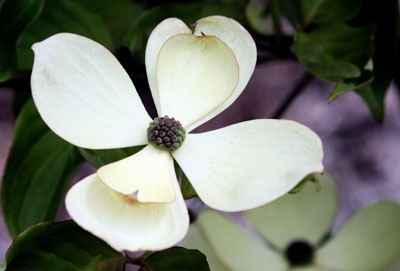
The oversized flowers of Cornus Venus (R). photo credit: D. Mattis
A recent recipient of the Gold Medal award is a stunning small flowering tree, Cornus Venus®. This dogwood is a hybrid between the Kousa dogwood, Cornus kousa and C. nuttallii. It resembles an upright version of the Kousa dogwood with oversized flowers.
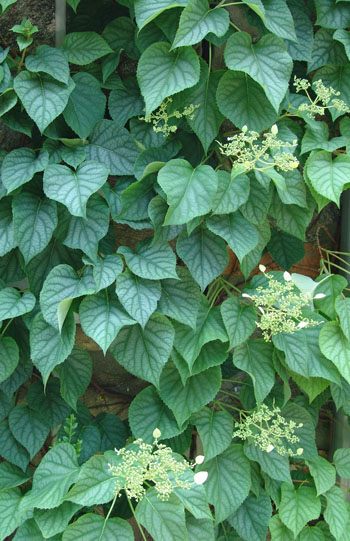
Schizophragma hydrangeoides 'Moonlight' photo credit: A. Bunting
The Gold Medal Program also boasts several vines including the Japanese hydrangea vine, Schizophragma hydrangeoides ‘Moonlight’. This self-clinging vine has rounded, pewter, variegated leaves which really stand out in shady spots. If this vine is given half-day sun, there will be spectacular flat-topped clusters of flowers in July. Each flower is made up of a large single bract which looks as if it is hovering above the foliage. Like its close relative the climbing hydrangea, Hydrangea anomala ssp. petiolaris, the Japanese hydrangea vine has excellent summer fragrance.
The aforementioned are merely thumbnail sketches of the dozens of Gold Medal specimens found in the Gold Medal Garden. A visit the Scott Arboretum will reveal the rich contribution this program has made to ornamental horticulture.





No Comments